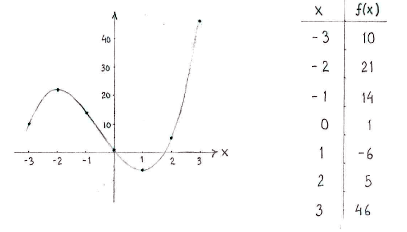Lösung 1.3:2c
Aus Online Mathematik Brückenkurs 2
There are three types of points at which the function can have local extreme points:
1. Critical points, i.e. where \displaystyle {f}'\left( x \right)=0;
2. Points where the function is not differentiable;
3. Endpoints of the interval of definition.
Because our function is a polynomial, it is defined and differentiable everywhere, and therefore does not have any points which satisfy \displaystyle 2 and \displaystyle 3.
As regards \displaystyle 1, we set the derivative equal to zero and obtain the equation
\displaystyle {f}'\left( x \right)=6x^{2}+6x-12=0
Dividing both sides by \displaystyle 6 and completing the square, we obtain
\displaystyle \left( x+\frac{1}{2} \right)^{2}-\left( \frac{1}{2} \right)^{2}-2=0
This gives us the equation
\displaystyle \left( x+\frac{1}{2} \right)^{2}=\frac{9}{4}
and taking the root gives the solutions
\displaystyle x=-\frac{1}{2}-\sqrt{\frac{9}{4}}=-\frac{1}{2}-\frac{3}{2}=-2
\displaystyle x=-\frac{1}{2}+\sqrt{\frac{9}{4}}=-\frac{1}{2}+\frac{3}{2}=1
This means that if the function has several extreme points, they must lie between
\displaystyle x=-2\text{ }
and
\displaystyle x=1.
Then, we write down a sign table for the derivative, and read off the possible extreme points.
TABLE
The function has a local maximum at \displaystyle x=-2\text{ } and a local minimum at \displaystyle x=1.
We obtain the overall appearance of the graph of the function from the table and by calculating the value of the function at a few points.
PICTURE TABLE

